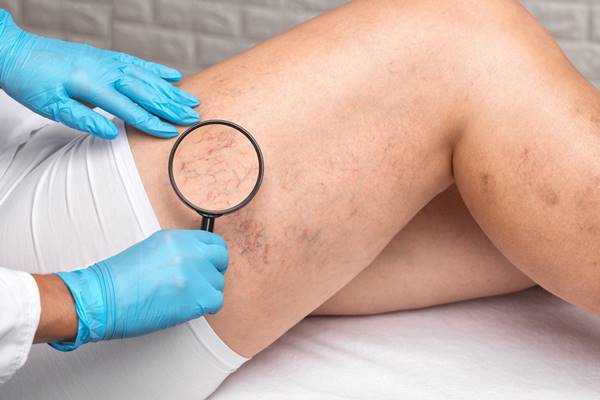Spider veins (or Thread Veins) are thin, twisted blood vessels that appear just beneath the skin’s surface. They are usually red, blue, or purple in color and can be seen on the legs, face, and other parts of the body. While spider veins are generally harmless and do not require treatment, they can be unsightly and cause discomfort in some cases.

What Are Spider Veins And Why Do They Occur?
Spider veins, also known as telangiectasias, are small dilated blood vessels that appear near the surface of the skin. Spider veins occur when small valves within the veins become weakened or damaged, causing blood to pool in these veins. This results in a visible web-like pattern of thin lines on the skin’s surface.
There are several factors that can contribute to spider veins.
Genetics play a significant role in their development, as they tend to run in families.
Hormonal changes during pregnancy or menopause can also lead to spider veins due to increased blood flow and pressure on the veins.
Obesity and prolonged standing or sitting can also increase pressure on the veins and cause them to become more visible.
While spider veins are usually harmless and do not cause pain or discomfort, they may be a cosmetic concern for some individuals. Treatment options include sclerotherapy, laser therapy, and radiofrequency ablation. Maintaining a healthy weight and avoiding prolonged periods of standing or sitting can help prevent their development.
Causes And Risk Factors Of Spider Veins
The causes of spider veins are not fully understood but may include genetics, age, hormonal changes, pregnancy, obesity, a sedentary lifestyle or prolonged standing or sitting. Spider veins occur when the small valves inside the veins fail to function properly causing blood to pool in the veins instead of flowing back to the heart.
Risk factors for developing spider veins include being female (due to hormonal changes), older age (as vein walls weaken over time), family history of vein problems (genetic factors), obesity (puts extra pressure on leg veins), prolonged standing or sitting (puts pressure on leg veins), history of blood clots or injury to the affected area.
While there is no surefire way to prevent spider veins from forming altogether, maintaining a healthy weight and an active lifestyle can help reduce your risk. If you already have spider veins and find them bothersome or painful, there are various treatments available including sclerotherapy (injection therapy) and laser therapy.
Symptoms And Diagnosis Of Spider Veins
The symptoms of spider veins include a web-like pattern on the skin’s surface, pain or discomfort in the affected area and swelling or inflammation around the affected veins.
Diagnosing spider veins can be done through a physical examination by a healthcare professional who will look for visible signs of these veins on your skin. In some cases, imaging tests like an ultrasound may be performed to check for any underlying issues. A thorough medical history review is also necessary to ensure there are no underlying health problems that could cause spider veins.
It’s important to note that spider veins are not typically a serious medical condition but they can cause self-consciousness and discomfort in some people. In rare cases, spider veins may indicate an underlying health issue such as deep vein thrombosis (DVT), so it’s important to seek medical attention if you experience any unusual symptoms related to spider veins. Treatment options include sclerotherapy and laser therapy which can help reduce or eliminate visible spider veins.
When To See A Doctor About Your Thread Veins: Warning Signs
Spider veins are a common cosmetic concern for many individuals, but they can also be an indication of underlying medical issues.
If you notice any changes in the appearance or feel of your thread veins, it is important to seek medical attention.
One warning sign to look out for is pain or discomfort in the affected area. Spider veins can cause aching, burning, or throbbing sensations that worsen with prolonged standing or sitting.
This could be a sign of venous insufficiency, which occurs when the valves in your veins fail to work properly and blood pools in the affected area.
Another warning sign is swelling or inflammation around the spider veins. This could be a sign of phlebitis, which is an inflammation of the vein wall that can lead to blood clots if left untreated.
Lastly, if you notice any changes in skin color or texture around your spider veins, such as redness, itching, or ulcers, it could be a sign of venous stasis dermatitis.
Treatment Options For Spider Veins
Thankfully, there are several treatment options available to reduce the appearance of spider veins:
1. Sclerotherapy: This is a common treatment for spider veins that involves injecting a solution directly into the affected vein. The solution causes the vein to collapse and eventually fade away.
2. Laser Therapy: This treatment uses intense bursts of light to heat and destroy the spider veins without damaging surrounding tissue.
3. Radiofrequency Ablation: This minimally invasive procedure uses heat generated by radiofrequency energy to close off the affected vein.
4. Compression Stockings: Wearing compression stockings helps improve blood flow in the legs and can help prevent new spider veins from forming.
5. Lifestyle Changes: Making lifestyle changes such as losing weight, exercising regularly, and avoiding prolonged periods of standing or sitting can help prevent new spider veins from forming.
6. Surgery: In rare cases where other treatments have failed or if there are underlying medical issues causing the spider veins, surgery may be necessary to remove them.
It’s important to note that while these treatments can reduce the appearance of existing spider veins, they do not prevent new ones from forming entirely. It’s always best to consult with a healthcare professional about which treatment option is best suited for your specific needs and medical history before proceeding with any treatment plan for spider veins.